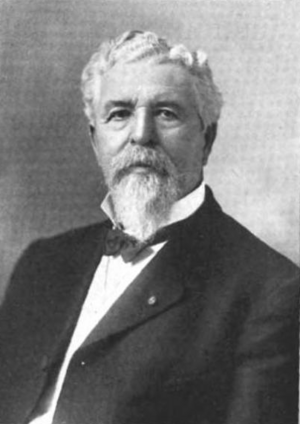Greenlief T. Stevens facts for kids
Quick facts for kids
Greenlief T. Stevens
|
|
|---|---|
 |
|
| Born |
Greenlief Thurlow Stevens
August 20, 1831 Belgrade, Maine
|
| Died | December 22, 1918 (aged 87) Augusta, Maine
|
| Education | Harvard Law School |
| Occupation | Banker, stockbroker, writer |
| Spouse(s) |
Mary Ann Yeaton
(m. 1856; died 1904) |
Greenlief Thurlow Stevens (1831–1918) was an important American soldier and leader during the American Civil War. He led the 5th Maine Battery, a group of artillery soldiers. Today, a special monument stands on Stevens' Knoll at the Gettysburg Battlefield, named after him. This area was one of the first parts of the battlefield saved for history.
Contents
Early Life and Education
Greenlief T. Stevens was born in Belgrade, Maine, on August 20, 1831. He was the youngest son of Daniel and Mahala Stevens. Greenlief went to local schools and later taught school himself.
He studied law with Samuel Titcomb in Augusta, Maine. Stevens became a lawyer in 1860, practicing in Belgrade and Augusta. He also went to Harvard Law School, finishing his studies in July 1861. He was about 30 years old when the Civil War began.
Civil War Service
Joining the Army
Stevens became a lieutenant in the 5th Maine Battery on January 31, 1862. The battery spent early 1862 training before going into battle. Captain George F. Leppien was in charge of the battery at first.
The 5th Maine Battery was part of the I Corps. They fought in the Second Battle of Bull Run, where one of their cannons helped protect the army's retreat. They also served at the Battle of Fredericksburg.
Battle of Chancellorsville
At the Battle of Chancellorsville, the 5th Maine Battery was ordered to support the II Corps. They were under heavy fire from Confederate cannons. The battery helped the 1st division of II Corps get out of a dangerous spot.
During this battle, Captain Leppien was badly wounded and later died. Lieutenant Edmund Kirby was also wounded. Lieutenant Stevens took over command of the battery. He was wounded by a shell fragment on May 3, 1862, but he kept leading his soldiers. The battery lost a quarter of its men killed or wounded.
Leading the 5th Maine Battery
After Chancellorsville, Stevens became the new captain of the 5th Maine Battery on June 21. His battery then joined the I Corps' artillery brigade.
Battle of Gettysburg
Stevens led the battery at the Battle of Gettysburg. On July 1, they fought near the Gettysburg Lutheran Seminary. They moved to cover the Chambersburg Pike. A Confederate group came very close to Stevens' cannons but was pushed back.
The Union line started to break, and the battery was ordered to pull back. They retreated through Gettysburg town to Cemetery Hill. They used heavy smoke from their own gunfire to cover their move.
The 5th Maine Battery was then placed on a hill between Culp's Hill and East Cemetery Hill. This hill is now named Stevens' Knoll after him. On July 2, Captain Stevens was wounded in the legs by a Confederate sharpshooter. Lieutenant Edward N. Whittier took command for the rest of the battle.
Under Whittier's lead, the battery fired at Confederate cannons on Benner's Hill. This firing helped stop the Confederate cannons. Both Stevens and Whittier used a special "ordnance glass" to help them aim their guns better.
On July 2, when Confederate groups attacked East Cemetery Hill, the battery fired into them. This firing helped limit the attack's success. Besides Captain Stevens, one lieutenant and 11 men were wounded. Six other men were captured during the retreat on the first day.
Later Campaigns
Stevens returned to command for the Bristoe Campaign and the Battle of Mine Run. Before the Overland Campaign of 1864, the 5th Maine Battery was moved to the Reserve Artillery. They took part in the Battle of the Wilderness, but were not heavily involved.
The battery then joined the VI Corps and supported their infantry at the Battle of Spotsylvania Court House and the Battle of North Anna. At the Battle of Cold Harbor, Stevens placed his cannons in earthworks to support the VI Corps. On June 3, Stevens had his gunners fire at Confederate positions. He also reported silencing a Confederate battery.
The battery was involved in the early parts of the Siege of Petersburg. On July 10, 1864, Stevens' battery was sent to defend Washington, D.C.. They also served in operations near Harpers Ferry, West Virginia.
Captain Stevens then served in the Union Army of the Shenandoah under General Philip Sheridan. They fought in the Battle of Opequan and the Battle of Cedar Creek. At Opequan, the 5th Maine helped the VI Corps advance. At Cedar Creek, Stevens' battery protected the right side of the VI Corps during a Confederate attack. Both General Wright and General Sheridan praised Stevens for his efforts.
The 5th Maine Battery stayed in the Army of the Shenandoah until the war ended. Stevens left the volunteer service on July 6, 1865. He was given the honorary rank of major on February 14, 1865.
After the War
After the war, Stevens served in the Maine Legislature. He was in the House of Representatives in 1875 and the Senate from 1877 to 1878.
Starting in 1888, Major Stevens served two terms as sheriff of Kennebec County. In 1892, he became a probate judge. Judge Stevens also served on Maine's commission for monuments on the Gettysburg battlefield. He was also active in his battery's veterans' association.
Stevens married Mary Ann Yeaton on March 25, 1856. They had three children, but only their son, Don Carlos, survived him. Greenlief T. Stevens died in Augusta, Maine, on December 22, 1918. He was buried in Woodside Cemetery in Belgrade.

